Log in
If you're a student, please log in, so you can get the most from this page.

This site is the textbook for your class. It also lets you upload your exercise submissions, get feedback, and other things. Here's how you use it.
Work through the lesson tree
The lesson tree is your table of contents for the course.
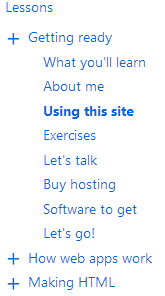
Start at the top, and keep going until you get to the end.
Each page is a lesson. Lessons are mostly text and images, with exercises and questions embedded in them.
Work on lessons from top to bottom
Don't skip to the bottom, find the exercise, and work back to the top. The exercise will be harder, since you won't know what you need to do.
Start at the top of each lesson, and work down.
The More buttons
The More buttons break lessons into chunks. They reduce the load on your brain, since you just think about one piece at a time.
The More buttons have an arrow, with a "Show all" option.

Click it, the More buttons vanish, and you can see the entire page.
Don't use "Show all" the first time you read a lesson. "Show all" is for when you've already read a lesson, and are coming back to find something to review, or code to cut-and-paste.
But, the first time you read a lesson, use the More buttons, one at a time. It's easier on your skull meat.
Reflection questions
Reflection questions are open-ended questions in lessons. They check whether you understood something. Each question has an area to type your response, plus a Continue button.
The rest of the lesson will be hidden, until you answer. You won't find what you need to know to do the exercises, unless you answer and click the Continue button.
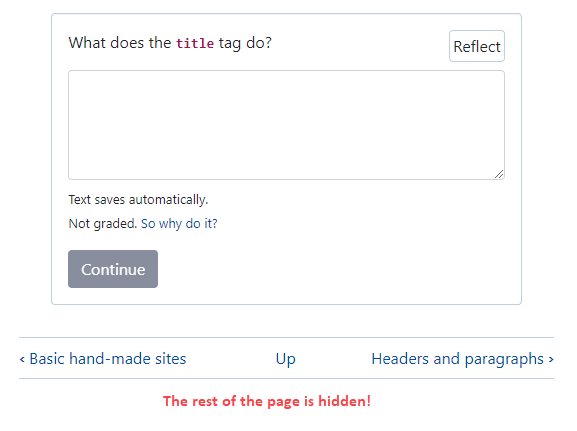
Do exercises when you find them in lessons
You can get to exercises in a few different ways, like through the Exercises link in the main menu's List option. That's not normally what you want to do, though.
Exercises are embedded in lessons. Do exercises as you come across them, when you're reading the lessons.

Adela
What are the other methods for?
They're for convenience when you're looking for feedback, checking your progress, or finding an exercise you did, so you can copy some of its code. However, when you want to work on new material, just start reading the next lesson.
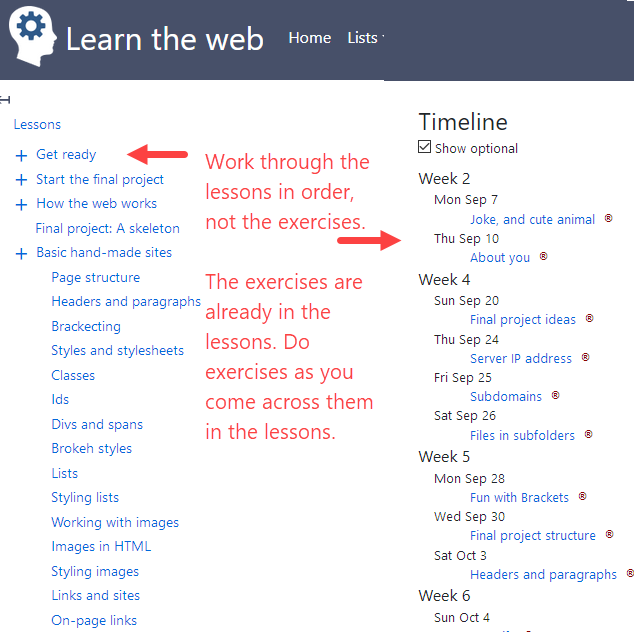
Answer the embedded questions
You'll find questions, like this:

Answer them.
The questions are not there to test you. Instead, they remind your brain of related things you've already learned. It helps you learn efficiently, by tying what you're about to read, to what you already know. You get more value from your study time.
When you don't understand something
Maybe you think smart people should understand things easily, the first time they read a lesson.

Here's me talking, Kieran, the dude who wrote this book-like-thing, and the software it runs on. I've got four college degrees, including two masters, and a doctorate. I've been learning about computers since the 1970s.
I've been learning Unity lately, a game programming platform. I get confused all the time. I read something, don't understand it, panic, and run away. Then I come back, and get it eventually.
If you understand everything you read in this book-like-thing, the first time you read it, then either...
- You've done this stuff before, or...
- You're from the planet Sploog.
When you don't understand something...
- Control your panic, if you can. Take a break. Come back to it, and read it again.
- Quiz yourself on what you read, as you go. This is my Top Tip for using study time efficiently.
- Ask someone else to explain it to you.
- Explain it to someone or something else. Like your dog. Seriously, that works.
- Ask me (Kieran).
- Ask the interwebs.
Let's try to help each other. This is not a death match course (check the syllabus on that). If you find something good on the 'net, share. If someone asks for help, give it. If you need help, ask.
Your account
You need an account on this site to submit exercises, and get feedback. I'll make an account for you, if you're in one of my OU courses. You'll get an email about it. If you don't have an account (maybe you added the course late, for example), contact me at mathieso@oakland.edu.
(If you're not in an official OU course, and want an account, contact me. I've made accounts for random people in the past.)
There's a login link in the main menu. When you've logged in, you'll see a "Your stuff" entry, with items like:
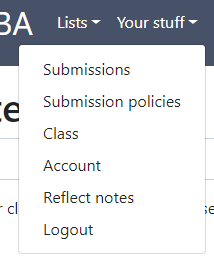
This is where you can see information specific to you. If someone else uses your computer, don't forget to log out.
Messing with your account
Your account has basic information, like your name, email, and maybe a photo. You can change the information with Your stuff | Account. That "|" means clicking "Your stuff" in the main menu, then clicking "Account".
Click Your stuff | Account, and you'll see something like:

There are two tabs, View and Edit. The View tab shows you account information. Click the Edit tab to change the information. That's where you'll change your password, for example.
You'll need to type your current password, and your new password (twice).
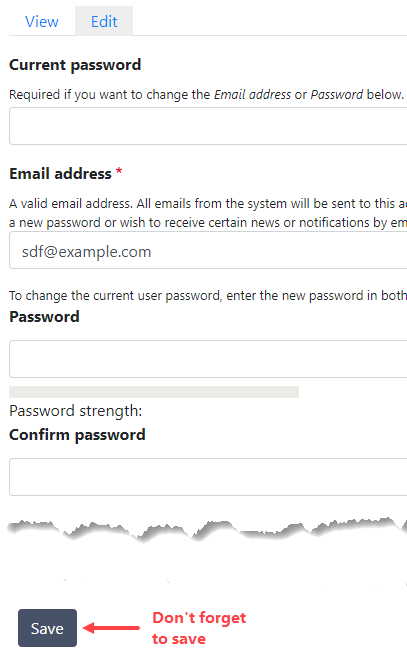
Don't forget to click the Save button at the bottom of the page.
Change your password
You should change your password now. That's Your stuff | Account | Edit.
Hint
Right-click (or long-press on a touch device) on the Account link, and it will show a menu that lets you open the link in a new browser tab. It's a good way to do something, without losing your place.

Ray
What if I forget my password?
No trubba. If you forget your password, there's a "Reset your password" link on the login form. It will send you an email with a reset link. If you don't get the email, check your spam folder.
Note
I don't have access to your password. It's encrypted. So try the reset link first. Remember, check your spam folder.
Turn on JavaScript and cookies for this site
This site uses JavaScript and cookies to keep you logged in, make the lesson tree work, and other stuff. Please let this site do its thing, or it will be hard to use. The site doesn't try to do Evil Things with JS or cookies
Suggestions
If you find a mistake, even a missing word or some such, please let me know. My email is in the syllabus.
Another thing. I know this stuff so well, I've forgotten what it's like to learn it. Things that are problems for you won't even occur to me. That's called the "expert's blind spot."
If an explanation confuses you, most likely there's a problem with the explanation, not you. And other people are probably confused, too. So, please suggest away!
We still need to talk about how you submit exercises. That's the next lesson.